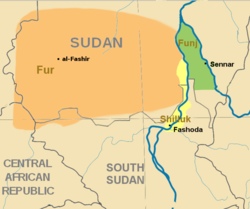Shilluk (Chollo) Kingdom Läg Cøllø or "Pödh Cøllø" or "Sudan" in Arabic | |||||||||||
|---|---|---|---|---|---|---|---|---|---|---|---|
| 15th century–1861 | |||||||||||
|
Flag | |||||||||||
 Shilluk Kingdom (yellow) and its neighbors | |||||||||||
| Capital | Fashoda (from the late 17th century)[1] | ||||||||||
| Largest city | Fashoda | ||||||||||
| Common languages | Shilluk | ||||||||||
| Religion | Imperial cult African Traditional Religion | ||||||||||
| Government | Divine monarchy | ||||||||||
| Rädh | |||||||||||
• 1490–1517 | Nyikaangø | ||||||||||
• 17th century | Odaagø Ocøllø[2] | ||||||||||
• 17th century | Rädh Tugø[2] | ||||||||||
| Historical era | Late medieval to early modern period | ||||||||||
• Established | 15th century | ||||||||||
• Disestablished | 1861 | ||||||||||
| Population | |||||||||||
• (1900s) | 200,000 (est) | ||||||||||
| |||||||||||
| Today part of | South Sudan Sudan | ||||||||||
The Shilluk Kingdom, dominated by the Shilluk people, was located along the left bank of the White Nile in what is now South Sudan and southern Sudan. Its capital and royal residence were in the town of Fashoda. According to Shilluk folk history and neighboring accounts, the kingdom was founded by Nyikang, who probably lived in the second half of the 15th century. A Nilotic people, the Shilluk managed to establish a centralized kingdom that reached its apogee in the late 18th and early 19th centuries, during the decline of the northern Funj Sultanate. In the 19th century, the Shilluk were affected by military assaults from the Ottoman Empire, resulting in the destruction of the kingdom in the early 1860s. The Shilluk king is currently not an independent political leader, but a traditional chieftain within the governments of South Sudan and Sudan. The current Shilluk king is Reth Kwongo Dak Padiet who ascended to the throne in 1993.[3]
The monarchy (the Reth) has been political and religious in nature. The monarch guaranteed social order; his health and the health of the nation were intertwined. Worship is performed in rituals inspired by the national myth of Nyikang, the first Reth. The Shilluk monarchy and the beliefs of its people was studied in 1911 by Charles Seligman and in 1916 by British anthropologist James George Frazer in The Golden Bough. Seligman described the Shilluk form of government as a "sacred kingship".[4]
- ^ Mercer 1971, pp. 407–408.
- ^ a b Cite error: The named reference
Ogotwas invoked but never defined (see the help page). - ^ https://ich.unesco.org/doc/src/00147-EN.pdf [bare URL PDF]
- ^ Seligman, Charles Gabriel (1934). Egypt and Negro Africa: A Study in Divine Kingship. Routledge and Sons.
